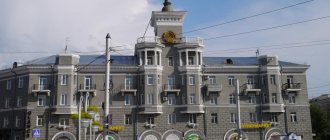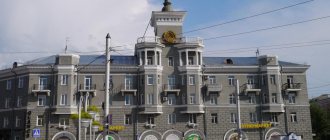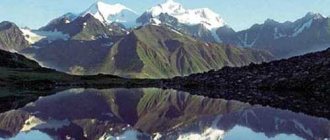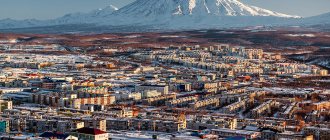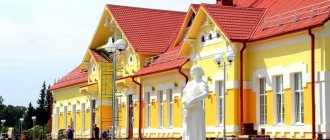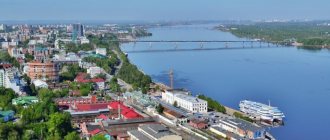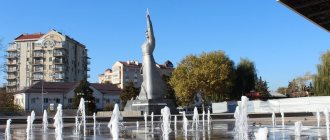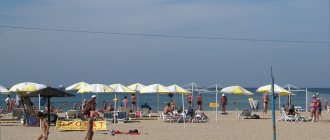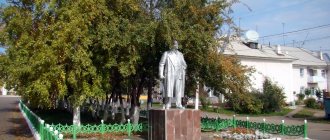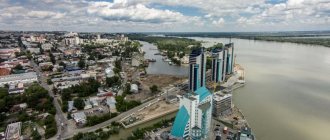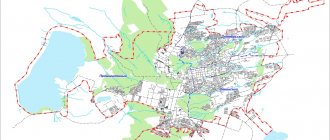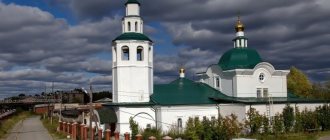Did you know that Zmeinogorsk was a modern city with stone buildings, at a time when Barnaul was practically still a village? So I didn’t know the history of the city of Zmeinogorsk until I came here and saw it. Everything here breathes history. The city has preserved many stone buildings of that time, the remains of a mine, and a museum of the history of mining. And the surrounding area of the city of Zmeinogorsk is rightly called Altai Switzerland. Here the Kulundinskaya steppe ends and the Altai mountains begin. But first things first.
Zmeinogorsk and its history
History of the city of Zmeinogorsk and mining in Altai
The history of the city of Zmeinogorsk is inextricably linked with the development of mining production in Altai. And it begins from the moment when ore explorers discovered a rich deposit of copper, silver ores and gold on Mount Zmeeva. This happened in 1736. Actually, they discovered and began to develop the deposit long before this moment.
Once upon a time in Siberia there lived a people whom historians call “Chud”. Very little is known about this people or peoples. Who they were, where they came from and where they disappeared is unknown. However, these were a people who had already mined various ores and processed them. Since then, many mining developments from those times have been found throughout Western Siberia. They are also found in Altai and the Salair Ridge and other places.
These workings were discovered on Mount Zmeeva
ore miners in the eighteenth century. Copper, silver ores and gold have already been found in them. This rich deposit was taken over by the famous entrepreneur and industrialist Akinfiy Demidov. The deposit turned out to be so rich that the mine built here was the main supplier of silver for the royal court for more than a hundred years. The surrounding area of the city of Zmeinogorsk has since been called Rudny Altai.
The city of Zmeinogorsk arose on the Karbolikha River, its tributary the Zmeyovka River, around Mount Zmeyovaya. The mine developed and expanded, and along with it the city of Zmeinogorsk developed and grew. Here, for the first time in Siberia, stone buildings were built. During the eighteenth and nineteenth centuries, the city of Zmeinogorsk was the second most populous city after Barnaul. The city of Zmeinogorsk was a major center of mining production in Russia, one of the cultural centers of Altai.
The city got its name from the name of the mountain
Serpentine, around which he settled down. And Mount Zmeinaya or Zmeyovaya and the Zmeevka River received this name for the abundance of snakes in these places. At one time, there was even a duty associated with snakes for residents. Residents of these places were obliged to catch snakes.
Why are there a lot of snakes in these places? There are many legends about this. According to one of them, the underground wealth of these places was guarded by snakes. But, most likely, the abundance of snakes is explained by the presence in the vicinity of the “Chudsky” workings, in which the snakes took refuge for the winter.
For the development of ores at the Zmeevsky mine
The most modern technologies were used. Here, for the first time in Russia, in 1806-1809, a cast-iron railway was built for transporting ore. It was built according to the design of the mine manager, engineer P.K. Frolov. Here, for the first time in Russia, lamps were used for miners working in the mine. Water energy was used to pump water out of the mine and bring ore to the surface.
On the Zmeyovaya River, designed by K.D. Frolov, a pond was built. Water was drained from it through a two-kilometer-long diversion canal and rotated huge wheels. These wheels were built inside the mine. Their size was amazing. The largest wheel was thirteen point six meters in diameter. These wheels already set in motion mechanisms for lifting ore and pumping water from the mine.
Zmeinogorsk was known as an industrial city not
only in Russia, but also abroad. Engineers from Europe sought to visit Zmeinogorsk. Domestic engineers considered it an honor to work here. A. Kulibin and I. Polzunov lived and worked here. At different times, famous people in Russia and the world P. Semenov-Tien-Shansky, F. Dostoevsky, A. Brem, A. Humboldt and many others visited here.
At the end of the nineteenth century, the deposit began to be depleted. The silver smelter was closed. Ore production volumes began to decline. The mine existed intermittently until the seventies of the twentieth century. And Zmeinogorsk finally turned into a small provincial city in the Altai Territory with a population of eleven thousand people.
Notes
- ↑ 123
www.gks.ru/free_doc/doc_2016/bul_dr/mun_obr2016.rar Population of the Russian Federation by municipalities as of January 1, 2016 - Law of the Altai Territory of November 27, 2008 No. 111-ZS “On the transformation of the municipal formation of the city of Zmeinogorsk, Altai Territory”
- [www.altairegion22.ru/rus/region_news/?news_id=47397 Deputies approved the terms of the legal procedure for the unification of Zmeinogorsk with the region]
- ↑ 12
[www.MojGorod.ru/altajsk_kraj/zmeinogorsk/index.html People's encyclopedia “My City”. Zmeinogorsk]. Retrieved July 1, 2014. [www.webcitation.org6QjydbNzu/ Archived from the original on July 1, 2014]. - [demoscope.ru/weekly/ssp/rus59_reg2.php All-Union Population Census of 1959. The size of the urban population of the RSFSR, its territorial units, urban settlements and urban areas by gender] (Russian). Demoscope Weekly. Retrieved September 25, 2013. [www.webcitation.org/6GDOghWC9 Archived from the original on April 28, 2013].
- [demoscope.ru/weekly/ssp/rus70_reg2.php All-Union Population Census of 1970 The size of the urban population of the RSFSR, its territorial units, urban settlements and urban areas by gender.] (Russian). Demoscope Weekly. Retrieved September 25, 2013. [www.webcitation.org/6GDOiMstp Archived from the original on April 28, 2013].
- [demoscope.ru/weekly/ssp/rus79_reg2.php All-Union Population Census of 1979 The size of the urban population of the RSFSR, its territorial units, urban settlements and urban areas by gender.] (Russian). Demoscope Weekly. Retrieved September 25, 2013. [www.webcitation.org/6GDOjhZ5L Archived from the original on April 28, 2013].
- [demoscope.ru/weekly/ssp/rus89_reg2.php All-Union Population Census of 1989. Urban population]. [www.webcitation.org/617x0o0Pa Archived from the original on August 22, 2011].
- ↑ 12345678910111213
ak.gks.ru/DBINET_DG/DBInet.cgi?pl=171205 Resident population as of January 1 - [akstat.gks.ru/wps/wcm/connect/rosstat_ts/akstat/resources/b69359804ea235f088bfb9189c529309/Volume 1. Number and distribution of population.pdf Results of the 2010 All-Russian Population Census for the Altai Territory. Volume 1. Number and distribution of population]. Retrieved March 6, 2015. [www.webcitation.org/6WpRPTbQK Archived from the original on March 6, 2015].
- ↑ 12
ak.gks.ru/DBINET_DG/DBInet.cgi?pl=171105 Population by municipalities as of January 1 (including by settlements) according to current records - [www.gks.ru/free_doc/doc_2013/bul_dr/mun_obr2013.rar Population of the Russian Federation by municipalities as of January 1, 2013. - M.: Federal State Statistics Service Rosstat, 2013. - 528 p. (Table 33. Population of urban districts, municipal districts, urban and rural settlements, urban settlements, rural settlements)]. Retrieved November 16, 2013. [www.webcitation.org/6LAdCWSxH Archived from the original on November 16, 2013].
- [akstat.gks.ru/wps/wcm/connect/rosstat_ts/akstat/resources/db0b3b8042d06d268d4bed553db9bdfa/prenumber.htm Altai Territory. Preliminary population estimate as of January 1, 2014 and average for 2013]. Retrieved May 14, 2014. [www.webcitation.org/6PZJQt0dD Archived from the original on May 14, 2014].
- [www.gks.ru/free_doc/doc_2015/bul_dr/mun_obr2015.rar Population of the Russian Federation by municipalities as of January 1, 2015]. Retrieved August 6, 2015. [www.webcitation.org/6aaNzOlFO Archived from the original on August 6, 2015].
- taking into account the cities of Crimea
- [www.gks.ru/free_doc/doc_2016/bul_dr/mun_obr2016.rar Population of the Russian Federation by municipalities as of January 1, 2016. Table “31. Population of cities and towns by federal districts and constituent entities of the Russian Federation as of January 1, 2016.” RAR archive (1.0 MB)]
- [www.amic.ru/news/?news_id=72663 The “Altai - Golden Mountains” expedition awakened the “heart of Asia”]
Sights of the city of Zmeinogorsk
In the city of Zmeinogorsk since its heyday
Many historical monuments have been preserved. The historical center of the city of Zmeinogorsk has been completely preserved. These are solid houses of one and two floors, built of brick. The office of the Zmeevsky mine, the House of Mining Officers, merchant shops and residential buildings of the merchants who lived here in those days have been preserved.
A mountain pond has been preserved, from which water was supplied to rotate the wheels that were used to lift ore and pump water out of the mine. Although these structures are not working, they are well preserved. They plan to restore them and show them to tourists. Remains of ore mining have been preserved, which can be seen in Mount Zmeevaya.
In Zmeinogorsk there is a Museum of the History of Development
mining production named after A. Demidov. It was founded in 1827 by the mine manager, engineer P.K. Frolov. For the first time in Russia, a brick building was built especially for the museum. At the entrance to the museum there are two cast iron cannons. Once upon a time these guns stood on Mount Karaulnaya, near Zmeinogorsk. There was a fortification there and the Cossacks guarded the city of Zmeinogorsk and the mine.
In the city of Zmeinogorsk, a winery founded in 1899 by royal decree has been preserved and operates. The location for the plant was not chosen by chance. Water for production is taken from a well drilled next to the plant. Since the plant is located next to the mine, the purest water enriched with silver and gold ions is obtained from the well. This gives it a unique taste. Posolskaya vodka, which was produced here, was known throughout the Soviet Union.
In the vicinity of Zmeinogorsk there are many deposits of ornamental stone. Stone products have been made here since ancient times. Eighty kilometers from Zmeinogorsk is the village of Kolyvan. A stone-cutting factory has been operating in Kolyvan for more than two hundred years. The products of this plant are in many museums around the world. And the most famous product - a stone vase made of jasper, with a bowl measuring five meters in diameter, is located in the Hermitage.
About twenty kilometers from Zmeinogorsk, near the village of Savvushki, the famous Kolyvan Lake is located. The surroundings of this lake are amazingly beautiful. Granite rock remains of bizarre shapes surround it on three sides. The lake is four kilometers long and up to two and a half kilometers wide. At the same time, Kolyvan Lake is shallow and warms up well. It's very good to relax here.
Ten kilometers from the village of Kolyvan is Mount Sinyukha. This is the highest point of the Kolyvan ridge. Mount Sinyukha is a place of pilgrimage for Christians. The height of the mountain is one thousand two hundred and ten meters. It is believed that if you drink water from a spring at the top of the mountain, wash your face with water from a granite bowl at the top and pray at the cross there, your soul will be calm and light for the whole year.
Links
- [administration-city-zmeinogorsk.rf/ City Administration]
Ishim fortified line Omsk fortress | Beteinskaya village | village Pustynnaya | Bolsheretsk outpost | Ust-Byzovskaya village | Yeisk outpost | Zudilovsky outpost | Rogalikha village | Ikovskaya village | Abatskaya Sloboda | village of Firsova | Korkinsky outpost | Kuturlinsky outpost | village of Bezrukova | Malyshkino village | Ust-Lamenskaya Sloboda | Omutnaya village | Rafaylovskaya Zaimka | Verkhsuerskaya Emutlinskaya settlement | village of Shmakovskoye | Ikovskaya Sloboda | Tsarevo Settlement | Utyatsky outpost | Yu outpost Tobol-Ishim fortified line Peschany redoubt | Presnogorkovskaya fortress | Presnogorkovsky redoubt | Boar Fortress | Presnoizbnaya redoubt | Presnovskaya fortress | redoubt Bolotokolodezny | Sarzhansky redoubt | Dubravny redoubt | Stanovaya fortress | Gagariy redoubt | Skopin redoubt | St. Peter's Fortress | Redoubt Flat | Midday Fortress | Medvezhiy redoubt | Redoubt Clean | Swan Fortress | Losev redoubt | Nicholas Fortress | Volchiy redoubt | Pokrovskaya fortress | Kurgan Redoubt | Stepnoy Redoubt | Melnichny redoubt | Omsk fortress Kolyvano-Kuznetsk fortified line (1749) Kuznetsk Fortress | Flavinsky outpost | Bekhtemirskaya village | Biysk fortress | Katun Fortress | Anui fortress | Nikolaev outpost | Kolyvan defense | Kabanov outpost | Kamikhskaya village | Kazan Redoubt | Belaya Stanitsa | Kolyvan plant | Zmeinogorsk mine | Aleysk outpost | outpost of St. Catherine | Spasskaya Stanitsa | Shemanaevsky outpost | Krasnoyarsk outpost | Shulbinsky plant | Shulbinsky outpost Kolyvano-Kuznetsk fortified line (1785): Kuznetsk Fortress | Kuzedeevsky outpost | Kandalepsky half-lighthouse | Sarychumysh lighthouse | Pyshtymsky half-lighthouse | Verkhneninsky lighthouse | Kayrakan Lighthouse | Uruninsky lighthouse | Nizhneninsky lighthouse | Saidyp outpost | Sailap lighthouse | Swan Lighthouse | Novikovsky lighthouse | Bekhtemir lighthouse | Biysk fortress | Katun Fortress | Smolensk defense | Anui fortress | Terek protection | Nikolaevsky lighthouse | Antonevsky outpost | Sludensky lighthouse | defense of the Horns of Morality | Sosnovsky lighthouse | Charysh outpost | Tulatin defense | Yarovsky lighthouse | Tigerek outpost | Beloretsk defense | Klyuchevsky lighthouse | Verkh-Aleysky outpost | Flat protection | Verkh-Ubinsk defense | Sekisovsky redoubt | Bobrov's defense | Uba lighthouse | Ust-Kamenogorsk fortress
How to get to the city of Zmeinogorsk
Getting to Zmeinogorsk is quite easy. The city of Zmeinogorsk is located 360 kilometers from the city of Barnaul. From the city of Barnaul you need to take the road to the city of Rubtsovsk. After two hundred and fifty kilometers, turn left to the village of Pospelikha. After it, follow the signs along the road to the regional center - the village of Kurya. Then we look at the signs for the city of Zmeinogorsk.
The road to Zmeinogorsk is asphalt and good. From Barnaul to Pospelikha the road is straight, wide, in some places there are two lanes in each direction. From Pospelikha to Zmeinogorsk it is quite good, one lane in each direction, but you need to be careful, as there are potholes made of broken asphalt.
From history and additional literature, I knew about Zmeinogorsk. But reading is one thing, but seeing everything with your own eyes is completely different. The trip to the city of Zmeinogorsk left an indelible impression in my memory. Monuments of history and nature will be remembered for a long time. And photographs taken during a road trip to the city of Zmeinogorsk will help you remember it over time.
Geography
The city is located at the southern foot of the Kolyvan ridge, at an altitude of 450 m, in the valley of the Korbolikha and Zmeevka rivers (tributaries of the Alei River), 360 km southwest of Barnaul. The nearest railway stations are Tretyakovo (45 km) and Rubtsovsk (87 km). Administratively, Zmeinogorsk includes the city itself and the village of Lazurka, located 25 km from the city.
Climate
Zmeinogorsk has a continental climate, moderated by the proximity of the mountains.
| Climate of Zmeinogorsk (norm 1981—2010) | |||||||||||||
| Index | Jan. | Feb. | March | Apr. | May | June | July | Aug. | Sep. | Oct. | Nov. | Dec. | Year |
| Average temperature, °C | −13,6 | −12,6 | −6,5 | 4,4 | 12,8 | 17,5 | 19,4 | 17,3 | 11,2 | 4,3 | −5 | −10,9 | 3,2 |
| Precipitation rate | 44 | 40 | 42 | 50 | 64 | 56 | 85 | 55 | 48 | 66 | 71 | 58 | 679 |
| Source: [meteo.ru/it/178-aisori FSBI “VNIIGMI-MTsD”] | |||||||||||||
| Climate of Zmeinogorsk | |||||||||||||
| Index | Jan. | Feb. | March | Apr. | May | June | July | Aug. | Sep. | Oct. | Nov. | Dec. | Year |
| Absolute maximum | 10,3 | 12,6 | 19,3 | 30,3 | 36,5 | 38,3 | 40,0 | 37,1 | 35,1 | 27,7 | 19,0 | 10,0 | 40,0 |
| Average maximum, °C | −9,1 | −7,6 | −1,8 | 9,9 | 19,1 | 23,9 | 25,5 | 23,8 | 18,2 | 9,5 | −0,6 | −6,7 | 8,6 |
| Average temperature, °C | −14,5 | −13,4 | −7,2 | 4,5 | 12,5 | 17,5 | 19,2 | 16,9 | 11,4 | 4,1 | −5,2 | −11,5 | 2,8 |
| Average minimum, °C | −20,4 | −19,7 | −13,6 | −1,9 | 4,7 | 10,0 | 12,5 | 9,6 | 4,2 | −1,3 | −10,3 | −16,9 | −3,7 |
| Absolute minimum, °C | −46,1 | −43,9 | −38,9 | −26 | −9,9 | −2,8 | 1,0 | 0,3 | −7,8 | −22,5 | −44,1 | −45 | −46,1 |
| Precipitation rate | 38 | 38 | 33 | 44 | 61 | 38 | 66 | 49 | 49 | 40 | 57 | 40 | 551 |
| Source: [climatebase.ru/station/36038/ Zmeinogorsk, Russian Federation]. Archive of climate data. [www.webcitation.org/67fzzJrjP Archived from the original on May 15, 2012]. | |||||||||||||
